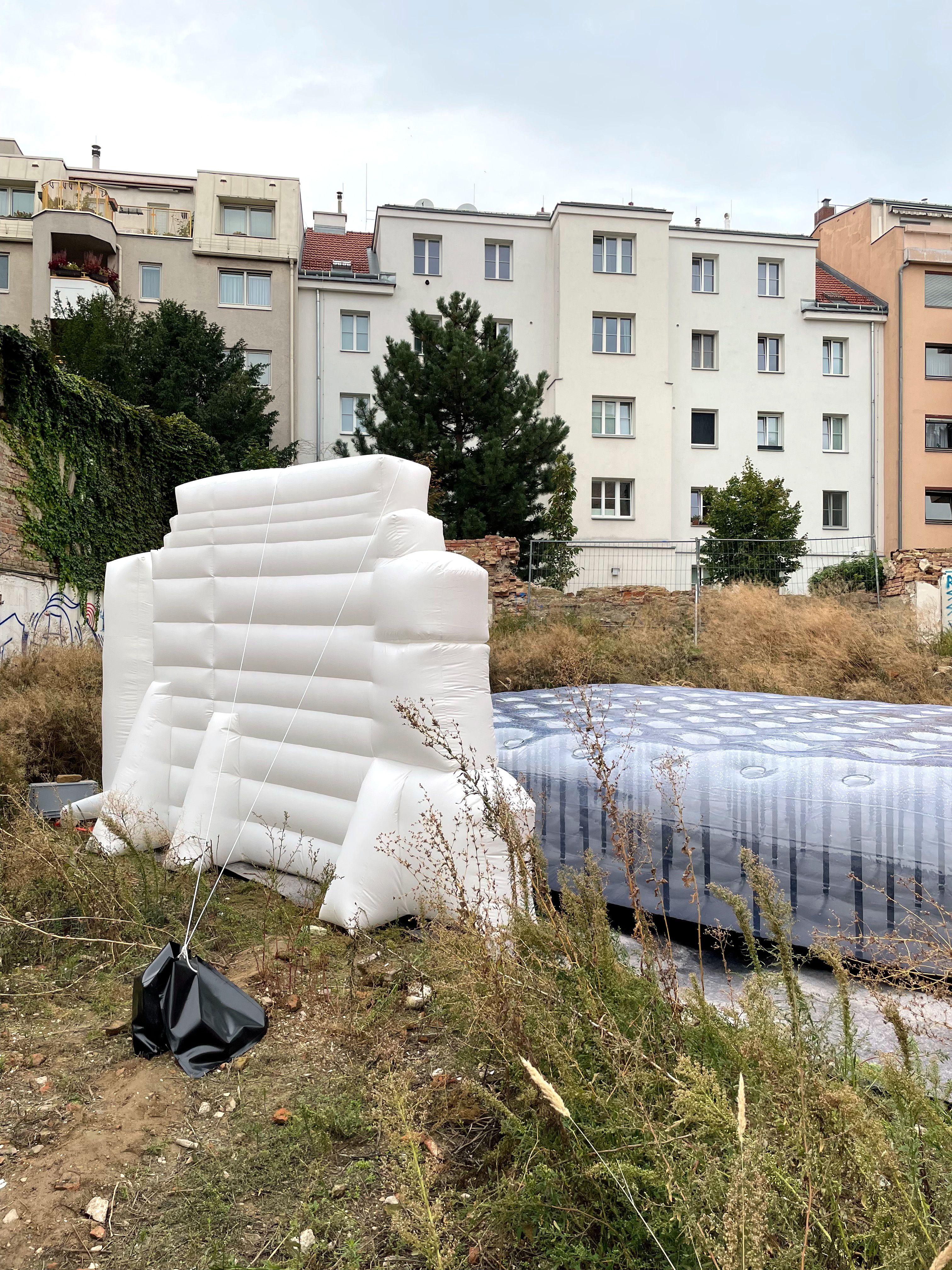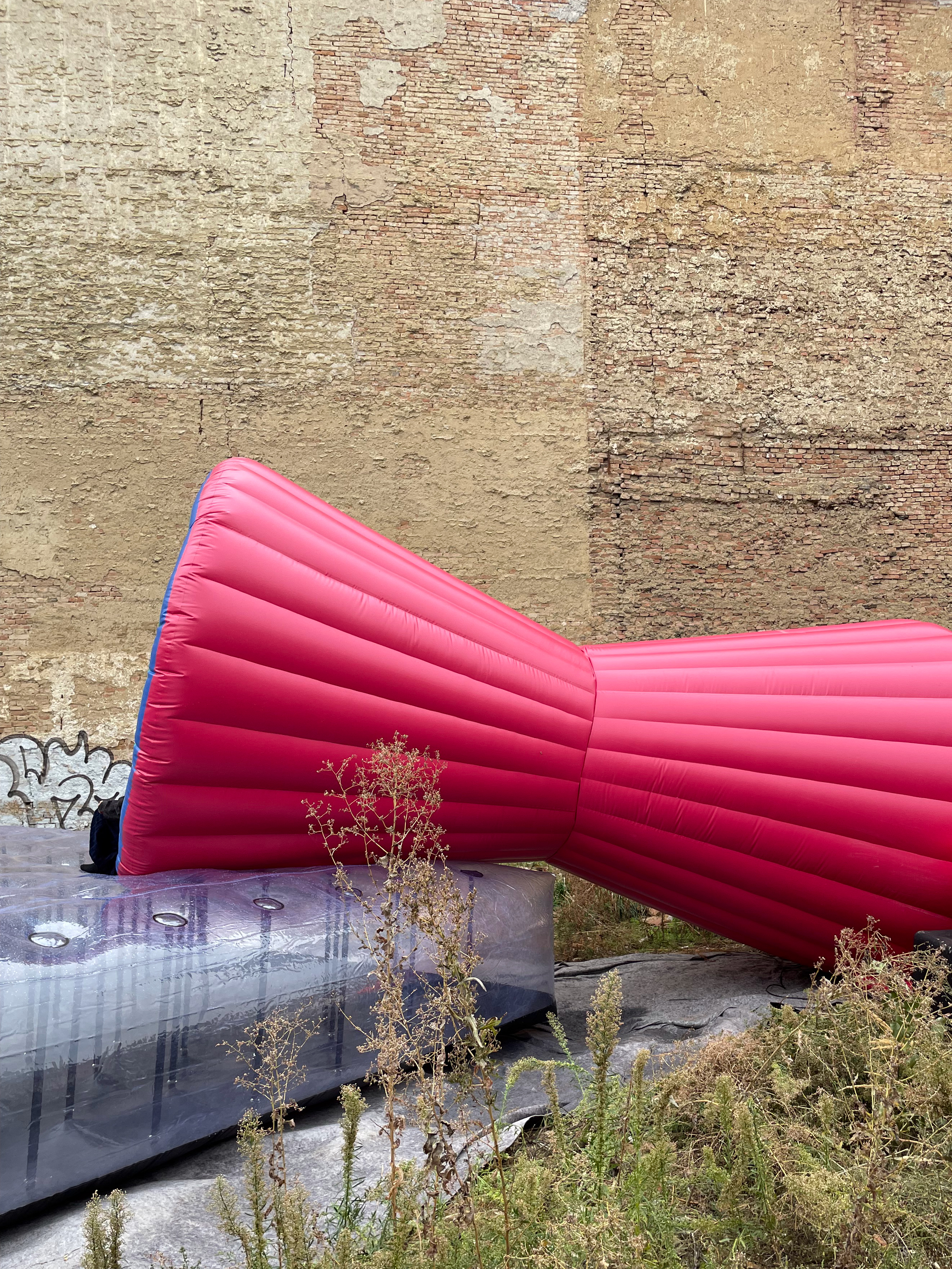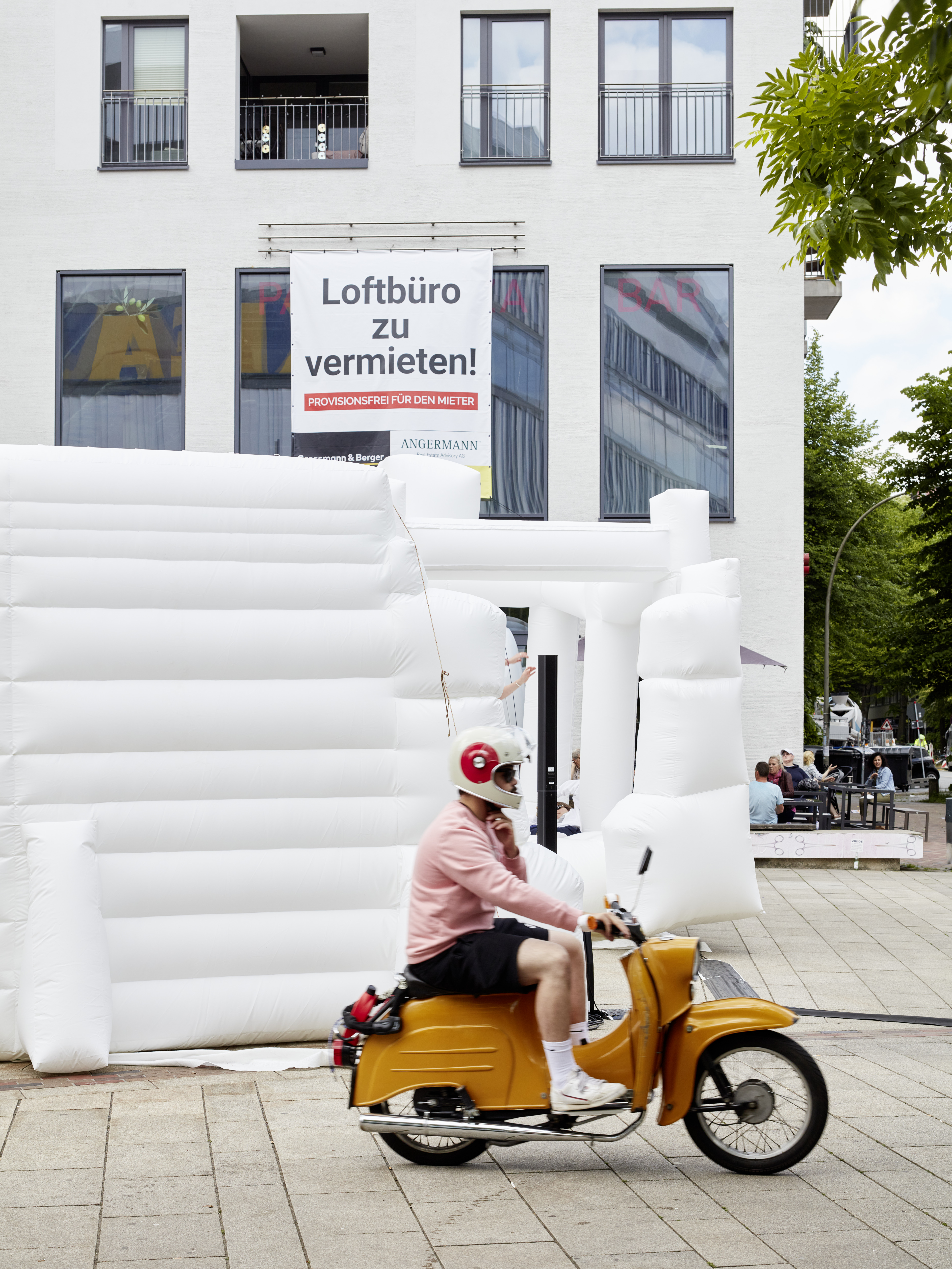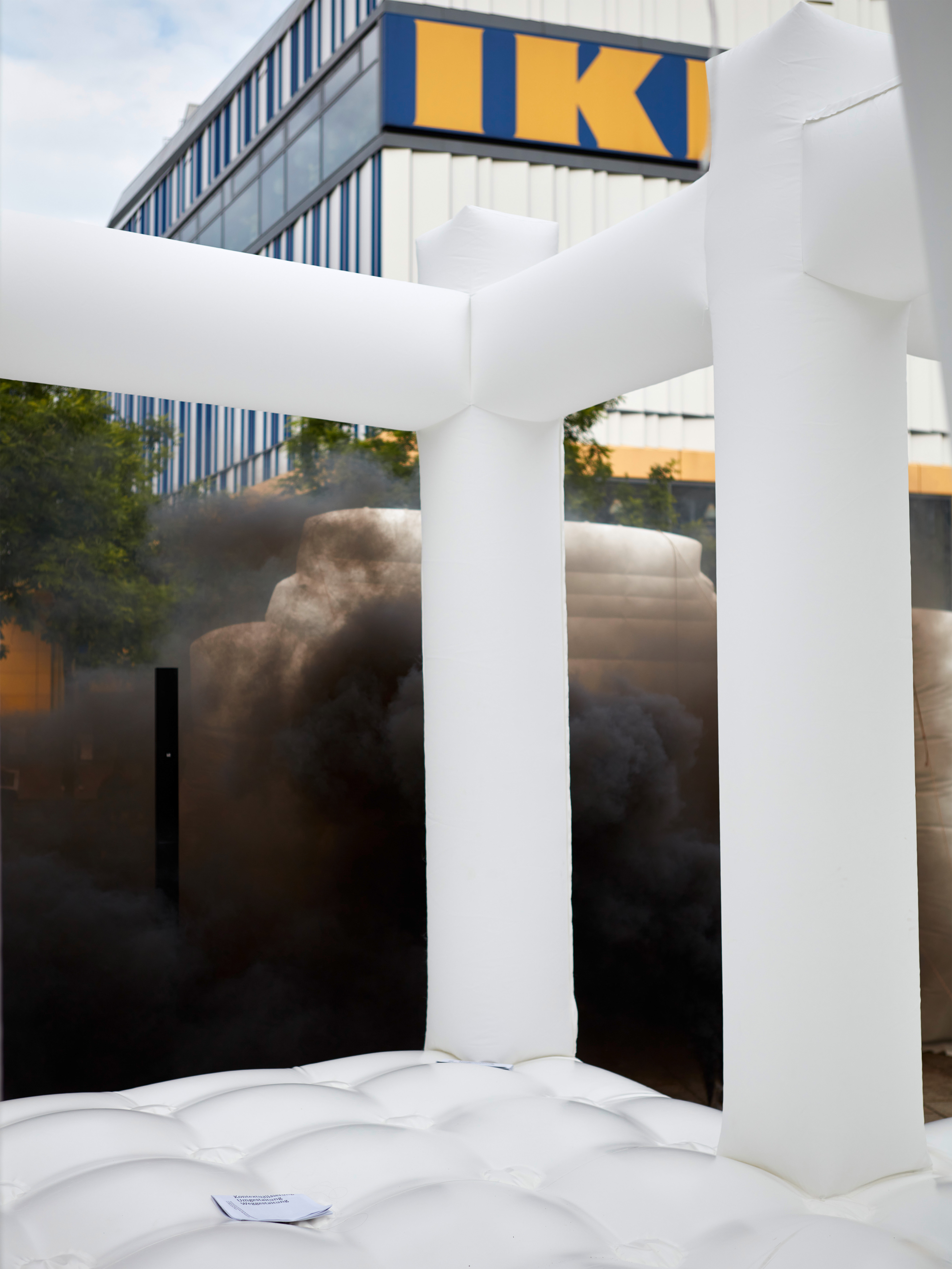
„Unter dem Pflaster liegt der Strand“ is the title of the collaborative installation by Frieder Bohaumilitzky and Ursula Klein on the occasion of the Vienna Design Week. The title is an adaptation of the well-known saying of the 68 movement and in this context refers to the political relevance of design projects in public space.
The contribution was part of the dialogic format of Passionswege, in which international design creators are brought together with Viennese craft businesses. Ursula Klein is the third generation of her family to run the plastic processing company schulteswien, which produces inflatable one-offs for artists and museums.
In their collaboration, Bohaumilitzky and Klein combined their passion for inflatable objects with their interest in political content. They used an space-filling inflatable ensemble to occupy a vacant lot between buildings in Vienna's 6th district.
During the day, the installation invited visitors to gather and hang out; in the evening, it became a space for discourse. In a series of open talks on the installation and in the adjacent workshop of schulteswien, the two discussed the potential of design in the face of current political challenges. The individual narrative elements of the installation served as starting points for the discussions with architects, filmmakers, historians, artists, politicians and political scientists.


Passionswege, Vienna Design Week
Concept: Frieder Bohaumilitzky · Ursula Klein / schulteswien
Curated by: Nadja Zerunian · Gabriel Roland
Setdesign: Frieder Bohaumilitzky · Ursula Klein / schulteswien
Production: Ursula Klein / schulteswien
→ Detailed program
Concept: Frieder Bohaumilitzky · Ursula Klein / schulteswien
Curated by: Nadja Zerunian · Gabriel Roland
Setdesign: Frieder Bohaumilitzky · Ursula Klein / schulteswien
Production: Ursula Klein / schulteswien
→ Detailed program

Mohamed Amjahid (Vortrag & Diskussion)
Wie aus der Parallelgesellschaft herausspringen?
Über homogen weisse Räume in der Stadt
Nora Sternfeld (Vortrag)
Errungene Erinnerungen
Kontaktzonen umkämpfter und geteilter Geschichte
Eduard Freudmann (Vortrag)
Kontextualisierung, Umgestaltung, Weggestaltung
Künstlerische und aktivistische Auseinandersetzungen mit geschichtspolitischen Manifestationen im öffentlichen Raum
Aram Bartholl (Performance & Gespräch)
Greetings from Hamburg!
Wie umgehen mit geschichtsrevisionistischer Architektur?
Gegenwärtig sind wir mit einer rechten Metapolitik konfrontiert, die mit kulturellen Setzungen versucht zivilgesellschaftliche Überzeugungen und kulturelle Diskurse jenseits von Parlamenten nach eigenen Vorstellungen zu verändern. Während das Konzept der Metapolitik eigentlich für den Aufbau einer demokratischen Zivilgesellschaft gedacht war, zielt die Neue Rechte darauf ab, gesellschaftliche Komplexität auf essentialistische Vorstellungen von Kultur, Nation und Volk zu reduzieren. Mit Rekonstruktionen historischer Architektur, ideologischer Inanspruchnahme von Orten, aber auch Angriffen auf Parlamente versucht sie abgeschlossene Identitäten zu konstruieren. Im Ringen um die kulturelle Hegemonie entwendet die Neue Rechte auch den Künsten ihre Strategien, mit denen zuvor noch für eine offene und vielfältige Gesellschaft eingetreten wurde. Sie richtet die performativen Methoden nun gegen die vielfältige Kultur selbst. Dafür dreht sie das kritische Potential der Künste in eine affirmative Symbolhaftigkeit um und verwendet das progressive Moment der Künste für ihre regressiven Ideen.
Obwohl die permanente Gefahr besteht, die entwickelten künstlerischen Praxen in den Händen von Personen mit autoritären und völkischen Vorstellungen wiederzufinden, besteht nach wie vor die Notwendigkeit mit Kunst Ideen davon zu entwickeln, wie wir als Gesellschaft gerne zusammenleben wollen. Metapolitisches Hüpfen bietet den Anlass, rechte Metapolitik zu diskutieren und schafft zugleich den Raum, um Gegenstrategien zu entwickeln. Um die Frage nach dem Umgang mit symbolischen Räumen so zuzuspitzen, dass sie sichtbar und diskutierbar wird, wird das Hambacher Schloss als Symbol für Demokratie aber auch nationalistische Vereinnahmung in eine antifaschistische Hüpfburg transformiert. Die Architektur wird zur Infrastruktur für ein eintägiges Symposium im öffentlichen Raum, das Widersprüchlichkeit zulässt und auf dem nicht nur theoretisch, sondern auch praktisch und performativ Strategien gegen rechte Metapolitik entwickelt, erprobt und debattiert werden.




Symposium und antifaschistische Hüpfburg
Große Bergstraße/ Goetheplatz, Hamburg
Mit Beiträgen von: Mohamed Amjahid · Nora Sternfeld · Eduard Freudmann · Aram Bartholl
Konzeption: Frieder Bohaumilitzky
Setdesign: Frieder Bohaumilitzky
Grafikdesign Flyer & Plakat: Torben Körschkes
Produktion Setting: Ursula Klein / schulteswien
Photos: Edward Greiner
www.metapolitisches-huepfen.de
Gefördert durch die Freie und Hansestadt Hamburg; Behörde für Kultur und Medien
Große Bergstraße/ Goetheplatz, Hamburg
Mit Beiträgen von: Mohamed Amjahid · Nora Sternfeld · Eduard Freudmann · Aram Bartholl
Konzeption: Frieder Bohaumilitzky
Setdesign: Frieder Bohaumilitzky
Grafikdesign Flyer & Plakat: Torben Körschkes
Produktion Setting: Ursula Klein / schulteswien
Photos: Edward Greiner
www.metapolitisches-huepfen.de
Gefördert durch die Freie und Hansestadt Hamburg; Behörde für Kultur und Medien

The mobilization attempts of the New Right are characterized by numerous discourse sovereignty appropriation tactics. This also applies to the re/interpretation and staging of symbolic spaces. How can the authoritarian appropriation of the right be countered by design strategies?
The starting point for the thematic discussion with and in this lecture-performance is a bouncy castle. As a materialized metaphor, the bouncy castle brings together our different research perspectives in productive friction. The bouncy castle itself symbolizes the observation that the self-image of a society is increasingly negotiated on the basis of and performed in symbolic spaces. «Bouncing» in this sense can be understood as a breaking out of rigid knowledge productions, as paralogy – displaced logos. The childish bouncing undermines the adult (academic) epistemological seriousness. Insight takes off, gets out of balance and when it arrives again it easily finds itself somewhere else, offset.
The bouncy castle can also point to aspects of a chaotic space, that is, to interdependencies, the recognition of complexity and unpredictability, and in this respect also poses the question of how we move in and through such spaces. For a movement of reduction and authoritarian appropriation does not fit this diverse and complex world. The bouncy castle is an attempt to develop an understanding of places as places of knowledge, of spaces as spaces of negotiation, of things as things of meaning. What (epistemological, design, theoretical) tools do we have at our disposal? What tools can we – as designers, artists, philosophers, social scientists– make available without these, in turn, being rigidly fixed, predetermined?
A specially made version of Hambach Castle (which is at the same time a symbol of «German democracy» and right-wing appropriation) as a bouncy castle – for this performative lecture – presents itself as a deliberately wobbly materialized demand to bring unrest into knowledge and entrenched thought practices.
Trailer:
Attending [to] Futures Conference, KISD - Köln International School of Design
Conception, Text, Performance: Tom Bieling · Frieder Bohaumilitzky · Anke Haarmann · Torben Körschkes
Edition / Sound / Conception: Stephan Kraus
Camera / Conception: Tamara Hildebrand
Support / Subtitles: Alice Lagaay
German original version with english subtitles
40 min.
Conception, Text, Performance: Tom Bieling · Frieder Bohaumilitzky · Anke Haarmann · Torben Körschkes
Edition / Sound / Conception: Stephan Kraus
Camera / Conception: Tamara Hildebrand
Support / Subtitles: Alice Lagaay
German original version with english subtitles
40 min.